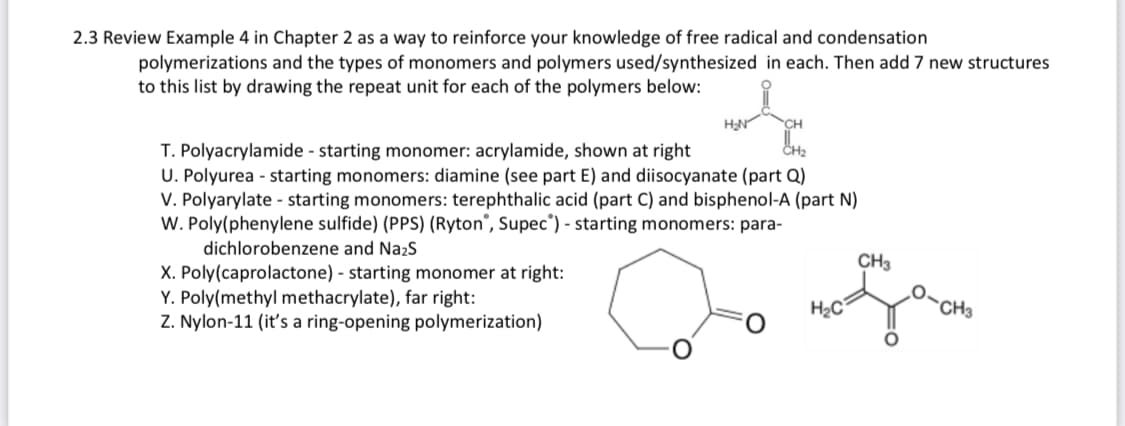2.3 Review Example 4 in Chapter 2 as a way to reinforce your knowledge of free radical and condensation polymerizations and the types of monomers and polymers used/synthesized in each. Then add 7 new structures to this list by drawing the repeat unit for each of the polymers below: CH CH₂ T. Polyacrylamide - starting monomer: acrylamide, shown at right U. Polyurea - starting monomers: diamine (see part E) and diisocyanate (part Q) V. Polyarylate - starting monomers: terephthalic acid (part C) and bisphenol-A (part N) W. Poly(phenylene sulfide) (PPS) (Ryton", Supec") - starting monomers: para- dichlorobenzene and Na₂S H₂N X. Poly(caprolactone) - starting monomer at right: Y. Poly(methyl methacrylate), far right: Z. Nylon-11 (it's a ring-opening polymerization) H₂C CH3 ge CH3
2.3 Review Example 4 in Chapter 2 as a way to reinforce your knowledge of free radical and condensation polymerizations and the types of monomers and polymers used/synthesized in each. Then add 7 new structures to this list by drawing the repeat unit for each of the polymers below: CH CH₂ T. Polyacrylamide - starting monomer: acrylamide, shown at right U. Polyurea - starting monomers: diamine (see part E) and diisocyanate (part Q) V. Polyarylate - starting monomers: terephthalic acid (part C) and bisphenol-A (part N) W. Poly(phenylene sulfide) (PPS) (Ryton", Supec") - starting monomers: para- dichlorobenzene and Na₂S H₂N X. Poly(caprolactone) - starting monomer at right: Y. Poly(methyl methacrylate), far right: Z. Nylon-11 (it's a ring-opening polymerization) H₂C CH3 ge CH3
Organic Chemistry
8th Edition
ISBN:9781305580350
Author:William H. Brown, Brent L. Iverson, Eric Anslyn, Christopher S. Foote
Publisher:William H. Brown, Brent L. Iverson, Eric Anslyn, Christopher S. Foote
Chapter8: Haloalkanes, Halogenation, And Radical Reactions
Section: Chapter Questions
Problem 8.34P
Related questions
Question

Transcribed Image Text:2.3 Review Example 4 in Chapter 2 as a way to reinforce your knowledge of free radical and condensation
polymerizations and the types of monomers and polymers used/synthesized in each. Then add 7 new structures
to this list by drawing the repeat unit for each of the polymers below:
H₂N
T. Polyacrylamide - starting monomer: acrylamide, shown at right
U. Polyurea - starting monomers: diamine (see part E) and diisocyanate (part Q)
V. Polyarylate - starting monomers: terephthalic acid (part C) and bisphenol-A (part N)
W. Poly(phenylene sulfide) (PPS) (Ryton, Supec") - starting monomers: para-
dichlorobenzene and Na₂S
X. Poly(caprolactone) - starting monomer at right:
Y. Poly(methyl methacrylate), far right:
Z. Nylon-11 (it's a ring-opening polymerization)
H₂C
CH3
CH3
Expert Solution
This question has been solved!
Explore an expertly crafted, step-by-step solution for a thorough understanding of key concepts.
This is a popular solution!
Trending now
This is a popular solution!
Step by step
Solved in 3 steps with 2 images

Knowledge Booster
Learn more about
Need a deep-dive on the concept behind this application? Look no further. Learn more about this topic, chemistry and related others by exploring similar questions and additional content below.Recommended textbooks for you

Organic Chemistry
Chemistry
ISBN:
9781305580350
Author:
William H. Brown, Brent L. Iverson, Eric Anslyn, Christopher S. Foote
Publisher:
Cengage Learning

Organic Chemistry: A Guided Inquiry
Chemistry
ISBN:
9780618974122
Author:
Andrei Straumanis
Publisher:
Cengage Learning

Organic Chemistry
Chemistry
ISBN:
9781305580350
Author:
William H. Brown, Brent L. Iverson, Eric Anslyn, Christopher S. Foote
Publisher:
Cengage Learning

Organic Chemistry: A Guided Inquiry
Chemistry
ISBN:
9780618974122
Author:
Andrei Straumanis
Publisher:
Cengage Learning